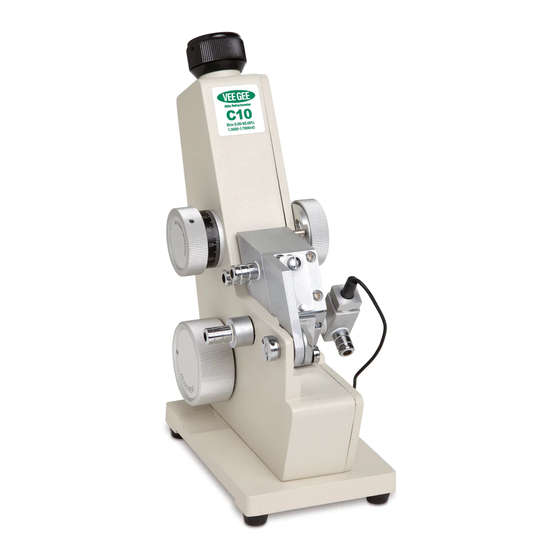
Summary of Contents for VEE GEE C10
- Page 1 Operation Manual Model C10 Abbe Refractometer 1.3000-1.7000 nD Brix 0-95% Catalog No. C10...
- Page 2 In no event shall VEE GEE Scientific LLC be held liable for any incidental or indirect damage arising from the use of modified or altered product.
- Page 3 It’s recommended this manual is read entirely before using the refractometer for the first time. VEE GEE Model C10 Abbe Refractometer is designed to measure the refractive index (nD) values of transparent and translucent solids and liquids. A constant temperature circulator can be attached to this instrument to stabilize refractive index readings and add to the instrument’s accuracy and reproducibility.
- Page 4 Refractometer Components Dispersion Correction Vernier Prism Lock Knob Dispersion Correction Knob Secondary Prism Light Cover Thermocoupler Secondary Prism Circulator Ports Thermometer Circulator Port Primary Prism Circulator Port Primary Prism Scale Adjustment Knob Prism Reflector...
- Page 5 Refractometer Components Eyepiece Calibration Screw Digital Thermometer Light Collector Thermometer Mount...
- Page 6 Calibration It is considered good laboratory practice to calibrate this refractometer using the liquids calibration procedure on a daily basis. Listed below also is a solids calibration procedure that can be performed occasionally if desired or as a part of your organization’s SOP. Liquid Calibration 1.
- Page 7 Measuring Liquids To find the refractive index or Brix value of any transparent or translucent liquid, the steps are similar to the calibration procedure. 1. Place 2-3 drops of the sample liquid on the surface of the primary prism. 2. Close and lock the secondary prism. Be sure the liquid covers the prism surface completely, without any gaps or bubbles.
- Page 8 Printed in China No. VGMNL042320-C10...


Need help?
Do you have a question about the C10 and is the answer not in the manual?
Questions and answers